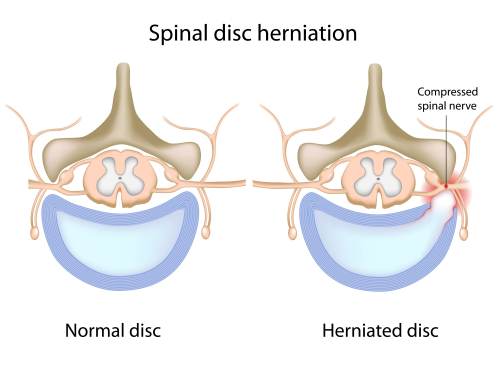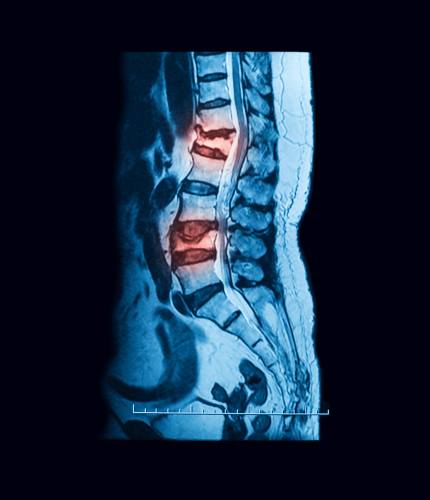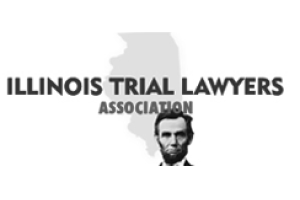Disc Herniations and Disc Bulges
Illinois Personal Injury Attorneys for Back Injuries After a Slip and Fall, Car Accident, or Pedestrian Accident
What are Disc Herniations and Disc Bulges?
The human spine is a complex structure composed of 33 vertebrae, extending from the cranium (skull) to the coccyx (tailbone). These vertebrae are categorized into five regions:
- Cervical spine (7 vertebrae)
- Thoracic spine (12 vertebrae)
- Lumbar spine (5 vertebrae)
- Sacral spine (5 fused vertebrae)
- Coccygeal spine (4 fused vertebrae)
The cervical, thoracic, and lumbar regions contain intervertebral discs that provide flexibility and act as shock absorbers. Each intervertebral disc consists of:
- A soft, gel-like center called the nucleus pulposus
- A tough, fibrous outer layer called the annulus fibrosus

A disc herniation (also known as a “slipped disc”) occurs when the nucleus pulposus pushes through a weakened or torn annulus fibrosus, potentially compressing the spinal cord and/or nerve roots, leading to pain, numbness, and weakness. In contrast, a disc bulge occurs when the disc protrudes beyond its normal boundary without rupture. While a disc bulge does not compress the spinal cord, it can still cause nerve compression and pain.
How Do Disc Herniations and Disc Bulges Occur?
Both conditions are commonly caused by age-related disc degeneration. However, disc herniations and disc bulges can occur from twisting the spine, slip and falls, or direct trauma, such as car accidents.
Risk factors include:
- Aging (discs lose hydration and flexibility over time)
- Repetitive spinal stress (e.g., lifting, bending, twisting)
- Obesity (increased load on the spine)
- Sedentary lifestyle (weakens core muscles, reducing spinal support)
- Smoking (reduces oxygen supply to discs, accelerating degeneration)
The Prevalence of Disc Herniations and Disc Bulges
- According to the American Academy of Orthopaedic Surgeons, disc herniation affects approximately 5-20 per 1,000 adults annually.
- The National Institute of Neurological Disorders and Stroke reports that 60-80% of adults will experience lower back pain at some point in their lifetime, with herniated discs being a leading cause.
- A study from the American Journal of Neuroradiology reports that the lumbar spine accounts for 90% of disc herniations, with the L4-L5 and L5-S1 levels being the most common sites.
What are the Symptoms of Disc Herniations and Disc Bulges?
Cervical Spine (Neck):

- Neck pain, stiffness, and muscle spasms
- Radiating pain to shoulders and arms
- Weakness, numbness, or tingling in hands or fingers
- Difficulty with balance and coordination
- Rarely, loss of bladder or bowel control
Thoracic Spine (Mid-Back):
- Localized pain in the mid-back region
- Radiating pain around the ribs and chest
- Numbness, stiffness, and muscle weakness in the legs
- Rare loss of bowel or bladder control
Lumbar Spine (Lower Back):
- Sciatica: sharp, electric-like pain radiating from the lower back to the legs
- Lower back pain, worsened by prolonged sitting or bending
- Leg weakness, numbness, or tingling
- Difficulty walking, coordination issues
- Rare bladder or bowel dysfunction
How Are Disc Herniations and Disc Bulges Diagnosed?
If you think you suffered a disc herniation or disc bulge, your physician will typically perform a physical examination and order imaging tests such as:
- X-ray – To rule out fractures and spinal abnormalities
- CT Scan – Provides detailed cross-sectional images of the spine
- MRI – The most effective tool for evaluating soft tissues, discs, and nerve compression
- Myelogram – Involves injecting dye into the spinal canal for enhanced imaging
- Electromyogram (EMG) – Measures nerve activity to determine affected nerve roots
Treatment Options for Disc Herniations and Disc Bulges
Conservative Treatments
- Rest and Activity Modification – Avoid movements that worsen pain
- Physical Therapy – Exercises to improve flexibility and strengthen spinal muscles
- Anti-inflammatory Medications – NSAIDs to reduce swelling and pain
- Epidural Steroid Injections – Reduce inflammation around affected nerves
Surgical Interventions
For severe cases, surgery may be necessary, including:
- Microdiscectomy – Removal of herniated disc material to relieve nerve pressure
- Laminectomy – Removal of a portion of the vertebra to create space for the spinal cord
- Spinal Fusion – Fusing two or more vertebrae for stability
What is a Disc Herniation or Disc Bulge Settlement Worth?
Personal injury settlements for disc injuries vary based on:
- Severity of injury
- Medical expenses (past and future)
- Lost wages and reduced earning capacity
- Pain and suffering
Average Settlement Amounts for Disc Bulges and Disc Herniations in Illinois:
- Mild disc injuries: $10,000 – $50,000
- Moderate cases (requiring injections/therapy): $50,000 – $150,000
- Severe cases (requiring surgery): $150,000 – $500,000+
How Can You Prevent Disc Herniations and Disc Bulges?
- Maintain good posture and ergonomic workstations
- Exercise regularly to strengthen core muscles
- Lift objects using proper techniques (bend at knees, not waist)
- Maintain a healthy weight to reduce spinal pressure
- Avoid smoking, which accelerates disc degeneration
Contact the Illinois Back Injury Attorneys at John J. Malm & Associates
Disc herniations and bulging discs are common yet treatable conditions that often cause significant pain and disability. Early diagnosis and appropriate treatment can help manage symptoms and prevent worsening conditions. If you or a loved one has suffered a disc injury due to an accident, consulting with the experienced Illinois personal injury attorneys at John J. Malm & Associates can help you understand your legal options and maximize your compensation.
Our dedicated back injury attorneys work hard to help you get the compensation you deserve and do not charge a fee upfront. We have offices in Naperville and St. Charles and serve clients throughout the state. Contact us today for a free consultation.








